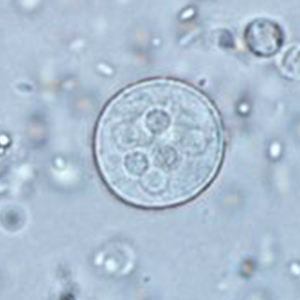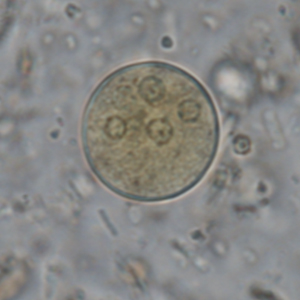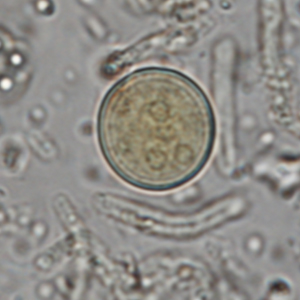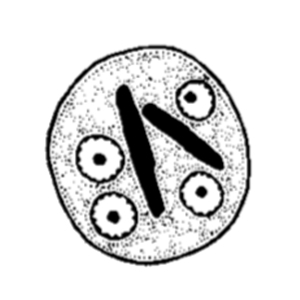Entamoeba histolytica is an amoeba which affects the cecum and colon of domestic carnivores, suids and primates.
Epidemiology
Entamoeba histolytica is a cosmopolitan parasite which has been described in many non-human primate species, including New World Monkeys (spider monkeys (Ateles spp.), marmosets (Callitrichidae), capuchin monkeys (Cebus spp.), howler monkeys (Alouatta spp.), woolly monkeys (Lagothrix spp.) and squirrel monkeys (Saimiri spp.)), Old World Monkeys (rhesus macaques (Macaca mulatta), pig-tailed macaques (Macaca nemestrina), bonnet macaques (Macaca radiata), crab-eating macaques (Macaca fascicularis), Barbary macaques (Macaca sylvanus), colobus monkeys (Colobus spp.), proboscis monkeys (Nasalis larvatus), African green monkeys (Chlorocebus spp.), guenons (Cercopithecus spp.), baboons (Papio spp.) and langurs (Colobinae)), and Apes (chimpanzees (Pan troglotydes), orangutans (Pongo pygmaeus), and gibbons (Hylobatidae)) (Strait et al., 2012; Regan et al., 2014). Two main forms have been identified in primates and need to be distinguished: E. histolytica histolytica which is pathogenic, and E. histolytica minuta, which is non-pathogenic.
It is a zoonosis and is one of the top three leading causes of death due to parasitosis in humans (Kantor et al., 2018).
Description
Entamoeba histolytica cysts are round, stain with Lugol and measure from 10 to 20 µm in diameter. They have a thick outer membrane and one to four subcentral nuclei with a voluminous and eccentric endosome and peripheric granulomatous chromatin. The number of nuclei depends on the degree of maturity of the cyst. Immature forms have one to four nuclei and an iodophilic vacuole, whereas mature forms have 4 nuclei without any vacuole. E. histolytica cysts also have crystalloid bodies with rounded tips (Euzéby, 2008). Details of the cysts can be underlined using trichrome or iron hematoxylin stains.
Differential diagnosis
Differential diagnosis includes medium-sized to large amoebas and non-parasitic structures. Differentiation is made based on the number of nuclei, size and visualization of different organelles with specific staining procedures. Indeed, Entamoeba coli cysts contain one to eight nuclei and their crystalloid bodies have sharp tips. They measure 10 to 35 µm in diameter. Entamoeba polecki cysts contains only one nucleus, associated to a lot of inclusion bodies. They measure 9 to 18 µm. Non-parasitic elements like spores do not contain intracytoplasmic structures and normally have a thicker and more refringent outer membrane (Strait et al., 2012).
To summarize, an amoeba-like cyst superior to 20 µm in diameter and/or that has more than 4 nuclei will always be an Entamoeba coli. Differentiation between immature E. coli cysts, E. polecki cysts and immature E. histolytica cysts is more complicated and may require the use of specific stains like trichrome or iron hematoxylin.
It is also important to differentiate E. histolytica histolytica from E. histolytica minuta. However, this requires complementary methods like coproculture to compare trophozoites. Specific kits also exist for the purpose (Strait et al., 2012)
Clinical significance
Entamoeba histolytica can be both symptomatic (digestive clinical signs), or asymptomatic.
Prophylaxis and treatment
As Entamoeba histolytica is zoonotic, hygienic measures need to be taken in case of diagnosis.
Various treatments of E. histolytica have been described in non-human primates:
- Metronidazole: 10-17 mg/kg PO q8h during 5 to 10 days seems to be the treatment of choice (Strait et al., 2012);
- Metronidazole-diiodohydroxyquinoline: 10 to 13 mg/kg PO q8h in case of severe infections (Strait et al., 2012; Calle & Joslin, 2015);
- Tetracycline: 25-50 mg/kg q24h during 5 to 10 days (Strait et al., 2012);
- Chloramphenicol: 50-100 mg/kg q12h (Strait et al., 2012);
- Paromomycin: 12.5-15 mg/kg PO q12h during 5 to 10 days (Strait et al., 2012; Calle & Joslin, 2015);
- Chloroquine phosphate: 5 mg/kg PO or IM q24h during 14 days (Calle & Joslin, 2015).





